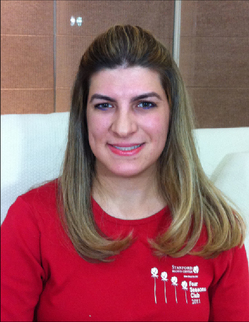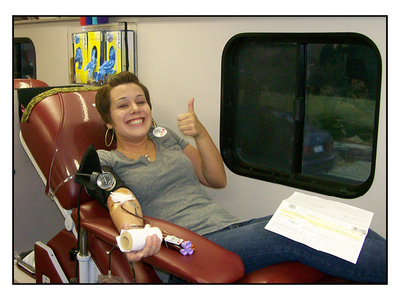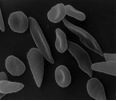Tag Archive: blood donation
December 6, 2011 at 12:10 pm
Published by Stanford Blood Center
By Marina Basina, M.D., a diabetes expert and Clinical Assistant Professor, Medicine - Endocrinology, Gerontology, Metabolism at Stanford University
Type I diabetes is an autoimmune condition in which the body's immune system inappropriately destroys the insulin-producing cells of the pancreas. Insulin is a key hormone which moves glucose into the cells and allows it to be utilized for energy and growth. Without insulin, glucose rises in the bloodstream, causing an abnormally high level of sugar in the blood.
December 2, 2011 at 8:21 am
Published by Stanford Blood Center
By Billie Rubin, Hemoglobin's Catabolic Cousin, reporting from the labs of Stanford Blood Center
Historically, certain species of leeches have been used in medicine for blood-letting. These tiny phlebotomists were used in areas that were "too sensitive or confined for the lancet or other blood-letting instruments" like the gums, lips, fingers, and nose.
November 30, 2011 at 10:40 am
Published by Stanford Blood Center

Many of our donors have unique stories about why they started giving blood. Through our #WhyIGiveBlood campaign, we are taking the opportunity to highlight some of them as an inspiration for others. This first piece in the series is by Tami Turner, a long-time, dedicated SBC blood donor.
My father is the reason I'm a 300+ unit donor. I grew up in the hills above Peninsula Hospital, for which my father was an on-call whole blood donor. He had AB blood, and would be called sometimes in the middle of the night to go down and donate.
When he died prematurely in 1985, it occurred to me that we were losing a whole generation of donors from WWII & Korean War eras, and that I needed to step up to the plate!

November 23, 2011 at 9:23 am
Published by Stanford Blood Center
As Jennifer Flowers sat in a hospital bed on January 8, 2010, she would have much rather been on a beach on one of the tropical islands she preferred to frequent. Walking through the surf on a sandy beach in Hawaii, the Bahamas, Barbados, Antigua, Bermuda, or Jamaica during one of her vacations was her idea of living. But that day, she was receiving a bone marrow transplant at Stanford Hospital that would keep her alive.
November 18, 2011 at 8:48 am
Published by Stanford Blood Center

By John Williams, Marketing Manager, Stanford Blood Center
Lisa Sanfilippo has donated blood in nine separate locations in the past five years. Such is her passion for continuing to help save lives by finding a Stanford Blood Center (SBC) blood drive or Center location wherever she happens to be when eligible to donate.
November 16, 2011 at 2:36 pm
Published by Stanford Blood Center

By Julie Ruel, Social Media Manager, Stanford Blood Center
Visiting a mobile blood drive is a convenient way for busy parents, students, and professionals to keep up with their routine of donating blood without having to travel too far. We come to you so you don't have to come to us! Accounting for about 55% of the total amount of blood we collect, our drives are hosted at college campuses, high schools, churches, and hundreds of companies in the Valley and up the Peninsula.

November 11, 2011 at 10:15 am
Published by Stanford Blood Center
By Dimone Gabler, recipient of blood products & champion of blood donors
I thought people who received blood either had surgery, a transfusion for a particular condition, or had been in a serious accident. I found out there are other reasons one might need blood. A few years ago, I thought I had a bad flu bug. After two to three days of not being able to keep anything down, my husband insisted I go to the doctor. I was so weak I was barely able to stand. After the doctor's examination, he sent me to the emergency room at Good Samaritan Hospital.
November 9, 2011 at 11:29 am
Published by Stanford Blood Center

By Julie Ruel, Social Media Manager, Stanford Blood Center
Being happy in life is a goal that many people across the globe have in common. So how is it then that we achieve happiness? Over the last decade or so, this has become a hot topic. Psychologists have plunged into the science of what brings people happiness and how to make it sustainable.
November 4, 2011 at 11:10 am
Published by Stanford Blood Center

By Billie Rubin, Hemoglobin's Catabolic Cousin, reporting from the labs of Stanford Blood Center
Sickle cells are abnormally shaped red blood cells (RBCs) caused by a mutation of the hemoglobin gene (Hgb S). Their less flexible, sickle-like shape leaves them unable to get through small capillaries, resulting in obstructed blood vessels in many organs. In addition, because of this sickle shape, the RBCs are sequestered and destroyed in the spleen at a faster rate than normal cells.
October 28, 2011 at 10:14 am
Published by Stanford Blood Center

By Julie Ruel, Social Media Manager, Stanford Blood Center
Each day, the recruitment team at Stanford Blood Center (SBC) works hard to help ensure we have blood products available to those in need. "We do this by connecting with donors and inviting them to return. It sounds simple enough, but the reality is that this mission takes time, strategy, and creativity," explains Karen Paganelli, recruitment manager at SBC. The hospitals' needs fluctuate from day to day and we must constantly keep on top of our inventory to make sure the right type is available at the right time for the right patient.







